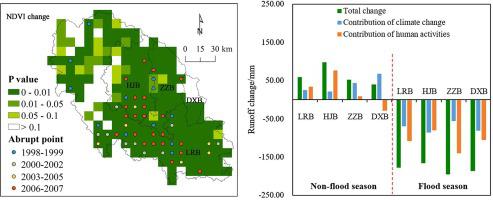Catena ( IF 5.4 ) Pub Date : 2020-06-03 , DOI: 10.1016/j.catena.2020.104705 Jinjiao Lian , Hongsong Chen , Fa Wang , Yunpeng Nie , Kelin Wang

|
Ecological restoration changes land cover types and management practices. However, understanding of their hydrological response is limited, especially in karst ecosystems, which are vulnerable to environmental changes. This study aimed to identify the spatial variability of the hydrological response in a mesoscale karst basin to climate change and ecological restoration. We examined changes in hydrological variables and normalized difference vegetation index (NDVI) from 1985 to 2015 in Longjiang River Basin (LRB) and its three main sub-basins, namely Huanjiang (HJB), Zhongzhouxiaojiang (ZZB), and Dongxiaojiang (DXB) sub-basins. The proportions of karst landscapes (POK) were 81, 66, 61, and 26%, respectively. Three independent quantitative methods were employed to distinguish the relative contributions of climate change and human activity. Annual runoff showed a good linear correlation with precipitation in all the basins, with insignificantly lower average values during 2003–2015 than during 1985–2002. The relative contribution of precipitation to annual runoff change varied from 17.5 to 52.9%. At a seasonal scale, flood season precipitation and runoff decreased with similar patterns of annual variation, whereas non-flood season values increased from 1985–2007 to 2008–2015. The quantitative results showed that the relative contribution rates of human activity to non-flood season runoff change were strongly linked to POK values and related vegetation changes. Annual NDVI improved after the implementation of ecological restoration projects, with change rates negatively related to POK values. Human activity was the dominant cause of increased non-flood season runoff in the LRB and HJB (accounting for 57 and 78%, respectively), whereas increases in non-flood season runoff in the ZZB and DXB were mainly caused by precipitation changes (accounting for 84 and 172%, respectively). These findings highlighted the facts that ecological restoration had changed hydrological processes and seasonal-scale analyses might therefore facilitate a better understanding of runoff changes in karst basins.
中文翻译:

区分中尺度喀斯特盆地气候变化和生态恢复对径流变化的相对贡献
生态恢复改变了土地覆盖类型和管理方式。但是,对它们的水文响应的理解是有限的,特别是在易受环境变化影响的喀斯特生态系统中。这项研究旨在确定中尺度喀斯特盆地对气候变化和生态恢复的水文响应的空间变异性。我们研究了1985年至2015年龙江流域(LRB)及其三个主要子流域(Hua江(HJB),中州小江(ZZB)和东小江(DXB))的水文变量和归一化植被指数(NDVI)的变化-流域。喀斯特景观(POK)的比例分别为81%,66%,61%和26%。三种独立的定量方法被用来区分气候变化和人类活动的相对贡献。年径流量与所有流域的降水都显示出良好的线性相关性,与1985-2002年相比,2003-2015年的年均值低得多。降水对年径流量变化的相对贡献从17.5%到52.9%不等。在季节性尺度上,汛期降水和径流量以类似的年变化模式减少,而非汛期值从1985-2007年到2008-2015年增加。定量结果表明,人类活动对非汛期径流变化的相对贡献率与POK值和相关的植被变化密切相关。实施生态修复项目后,年度NDVI有所改善,变化率与POK值负相关。人类活动是LRB和HJB非洪水季节径流量增加的主要原因(分别占57%和78%),而ZZB和DXB非洪水季节径流量的增加主要是由降水变化引起的(占分别为84%和172%)。这些发现突出了这样一个事实,即生态恢复已经改变了水文过程,因此季节性尺度分析可能有助于更好地了解喀斯特盆地的径流变化。











































 京公网安备 11010802027423号
京公网安备 11010802027423号